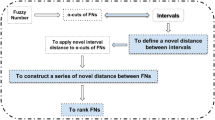Abstract
In this paper, a new approach for comparison among fuzzy numbers based on new metric distance (D TM) is proposed. All reasonable properties of ranking function are proved. At first, the distance on the interval numbers based on convex hall of endpoints is proposed. The existing distance measures for interval numbers, (Bardossy and Duckstein in Fuzzy rule-based modeling with applications to geophysical, biological and engineering systems. CRC press, Boca Raton, 1995; Diamond in Info Sci 46:141–157, 1988; Diamond and Korner in Comput Math Appl 33:15–32, 1997; Tran and Duckstein in Fuzzy Set Syst 130:331–341, 2002; Diamond and Tanaka Fuzzy regression analysis. In: Slowinski R (ed) Fuzzy sets in decision analysis, operations research and statistics. Kluwer, Boston, pp 349–387, 1998) do not satisfy the properties of a metric distance, while the proposed distance does. It is extended to fuzzy numbers and its properties are proved in detail. Finally, we compare the proposed definition with some of the known ones.

Similar content being viewed by others
References
Abbasbandy S, Asady B (2006) Ranking of fuzzy numbers by sign distance. Inf Sci 176:2405–2416
Bardossy A, Duckstein L (1995) Fuzzy rule-based modeling with applications to geophysical, biological and engineering systems. CRC press, Boca Raton
Bardossy A, Hagaman R, Duckstein L, Bogardi I (1992) Fuzzy least squares regression: theory and application. In: Kacprzyk J, Fedrizi M (eds) Fuzzy l. Omnitech Press, Warsaw and Physica-Verlag, Heidelberg, pp 181–193
Bortolan G, Degan R (2006) A review of some method for ranking fuzzy sets. Fuzzy Sets Syst 15:1–19
Caldas M, Jafari S (2005) θ-Compact fuzzy topological spaces. Chaos Solitons Fractals 25:229–232
Chang SL, Zadeh LA (1972) On fuzzy mapping and control. IEEE Trans Syst Man Cybern 2:30–34
Cheng CH (1998) A new approach for ranking fuzzy numbers by distance method. Fuzzy Sets Syst 95:307–317
Li DF, Yang JB (2004) Fuzzy linear programming technique for multiattribute group decision making in fuzzy environments. Inf Sci 158:263–275
Diamond P (1998) Fuzzy least squares. Inf Sci 46:141–157
Diamond P, Korner R (1997) Extended fuzzy linear models and least squares estimates. Comput Math Appl 33:15–32
Diamond P, Tanaka H (1998) Fuzzy regression analysis. In: Slowinski R (ed) Fuzzy sets in decision analysis, operations research and statistics. Kluwer, Boston, pp 349–387
Dubois D, Prade H (1980) Fuzzy sets and systems: theory and applications. Academic Press, New York
Elnaschie MS (2004) A review of E-infinity theory and the mass spectrum of high energy particle physics. Chaos Solitons Fractals 19:209–236
Elnaschie MS (2006a) Elementary number theory in superstrings, loop quantum mechanics, twistors and E-infinity high energy physics. Chaos Solitons Fractals 27:297–330
Elnaschie MS (2006b) Superstrings, entropy and the elementary particles content of the standard model. Chaos Solitons Fractals 29:48–54
Feng G, Chen G (2005) Adaptive control of discrete-time chaotic systems: a fuzzy control approach. Chaos Solitons Fractals 23:459–467
Fortemps P, Roubens M (1996) Ranking and defuzzification methods based on area compaensation. Fuzzy Sets Syst 82:319–330
Goetschel R, Vaxman W (1981) A pseudometric for fuzzy sets and certain related result. J Math Anal Appl 81:507–523
Goetschel R, Vaxman W (1983) Topological properties of fuzzy numbers. Fuzzy Sets Syst 10:87–99
Huang H, Wu CH (2009) On the triangle inequalities in fuzzy metric spaces. Inf Sci (in press)
Jiang W, Guo-Dong Q, Bin D (2005) H ∞ variable universe adaptive fuzzy control for chaotic system. Chaos Solitons Fractals 24:1075–1086
Ma M, Kandel A, Friedman M (2000a) A new approach for defuzzification. Fuzzy Sets Syst 111:351–356
Ma M, Kandel A, Friedman M (2000b) Correction to “a new approach for defuzzification”. Fuzzy Sets Syst 128:133–134
Modarres M, Nezhad SS (2001) Ranking fuzzy numbers by preference ratio. Fuzzy Sets Syst 118:429–439
Negoita CV, Ralescu DA (1975) Applications of fuzzy sets to systems analysis. Wiley, Now York
Ekel PY, Fernando H, Schuffner Neto (2006) Algorithms of discrete optimization and their application to problems with fuzzy cofficients. Inf Sci 176:2846–2868
Slavka B (2003) Alpa-bounds of fuzzy numbers, Inf Sci 152:237–266
Tanaka Y, Mizuno Y, Kado T (2005) Chaotic dynamics in the Friedman equation. Chaos Solitons Fractals 24:407–422
Tran L, Duckstein L (2002) Comparison of fuzzy numbers using a fuzzy distance measure. Fuzzy Sets Syst 130:331–341
Wang X, Kree EE (2001) Reasonable properties for the ordering of fuzzy quantities I. Fuzzy Sets Syst 118:375–385
Xu R, Li C (2001) Multidimensional least-squares fitting with a fuzzy model. Fuzzy Sets Syst 119:215–223
Yang MS, Ko (1997) On cluster-wise fuzzy regression analysis. IEEE Transaction on Systems. Man Cybern B 27:1–13
Yao JS, Wu K (2000) Ranking fuzzy numbers based on decomposition principle and signed distance. Fuzzy Sets Syst 116:275–288
Xu ZS, Chen J (2009) An iteractive metchod for fuzzy multiple attribute group decision making. Inf Sci (in press)
Author information
Authors and Affiliations
Corresponding author
Rights and permissions
About this article
Cite this article
Allahviranloo, T., Firozja, M.A. Ranking of fuzzy numbers by a new metric. Soft Comput 14, 773–782 (2010). https://doi.org/10.1007/s00500-009-0464-7
Published:
Issue Date:
DOI: https://doi.org/10.1007/s00500-009-0464-7




